| |  | |
|
Galleries
| "Beam of light" These
images were taken in an abandoned silo near Heemstede, the Netherlands, which
has now been demolished to be replaced by a modern apartment building. I was particularly
captivated by the beautiful light in this structure. It is rare nowadays in the
Netherlands to find such buildings slowly decaying to ruins... Minolta
Dynax 7, Sigma 28-70 2.8 EX | 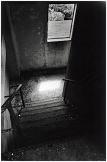 |
| "Attack of the Ents" Zero
Image 4x5 pinhole, Ilford Warmtone FB, split sepia and selenium toned | 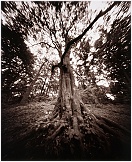 |
| "Heliflight" This
was a reportage I shot for the Heliflight
company. Heliflight is a successful young company owned by equally young and charismatic
Jan van Meerveld (he's the one fuelling the helicopter in one of these images).
Together with a dedicated team he offers helicopter flights for fun, VIP flights,
television-, film- and photo flights and the like. I liked the
energetic atmosphere accompanying this event, in this case a number of fun flights
for an amateur football club in the Netherlands. I shot most of the pictures on-ground,
but also went on a flight with the helicopter. This turned out to be a though
job. Flying circles above a city centre at 45 degrees angle and taking pictures
is not particularly good for your well being... A helicopter's tremendous flexibility
in movements leaves you disorientated completely in just a few minutes. Still,
I managed to create a number of interesting shots, for example the extreme close
up portrait of the pilot has been taken in full flight, as can be judged by the
reflection of the horizon in his sun glasses. Minolta Dynax 7,
Sigma 28-70 2.8 EX | 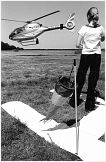 |
| "Single and experimental photos" A
gallery of individual photos, not (yet) part of any larger series, and some experimental
work. Divers equipment (35mm, 4x5) | 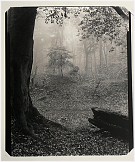 |
| "Siena at night time", Italy This
small town kept surprising me during a two weeks stay there. The beautiful architecture,
in the form of magnificent buildings like the "Il Duomo" cathedral,
cobbled roadways and a still almost intact city wall, all combined in the experience.
Especially at night time, the city came to live for me, showing what it was made
of in it's gorgeous display of shadows and lights. Although
some people might argue that such historic towns are "something from the
past" or "living museums", to me such towns are a testimony of
the endurance of ancient civilizations and thriving societies. Standing at night
time in some of the small "vicoli", that are hidden in the maze of curving
streets that litter the hilltops on which Siena is build, to take pictures, I
could hear the sound of live going on behind the walls. Families preparing their
diners as they may have done in these very same buildings hundreds of years ago.
An amazing thought... If ever we needed to know how to
live sustainable, the continued usage of these towns is a prime example. Rather
than demolishing entire, often poorly build, city quarters after just half a century
or so - as is common place in the Netherlands - some of these historic buildings
have been lived in for almost a millennium. They may have been changed over time
to adapt to new needs, but their core structure will stand for another thousand
years if need be. Long after you and I have left this planet...
Tachihara
4x5 | 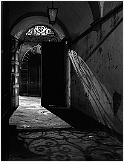 |
| "Siena at dusk" Tachihara
4x5 | 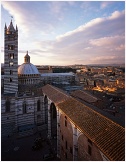 |
| "Monsterball" Datura
Stramonium - Doornappel Minolta Dynax 7, Minolta 50mm 1.7 + close
up lens | 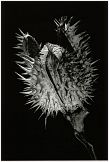 |
| "Fort Vechten" This
is my very first attempt creating sepia toned images.
Fortress "Fort
Vechten" is part of a defensive line of some 30 fortresses build between
about 1840 up to 1890, that was supposed to protect the western part of the Netherlands
from foreign invasion. It used a unique defensive approach, using the fortresses
in combination with careful controlled flooding of the polders surrounding them,
making passage of armies impossible. The "Nieuwe Hollandse Waterlinie"
now runs for inclusion on the World Heritage List of the UNESCO. Actually,
the Netherlands has seen four of such major defensive lines (not accounting things
like the Roman borderline and a few other smaller structures...). In order of
age (old to new): Tachihara 4x5 | 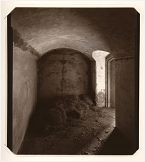 |
| "Amsterdam by night" Zero
Image 4x5 pinhole, Ilford Warmtone RC, selenium toned | 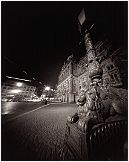 |
| "Amsterdam by day" Zero
Image 4x5 pinhole, Kentmere VC Select, split sepia and selenium toned | 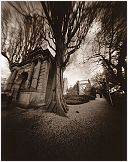 |
| "Fate" Minolta
Dynax 7, Sigma 28-70 2.8 EX |  |
| "Steam pumping station 'Gemaal
Halfweg'" As one of the last remaining steam powered pumping
stations, "Gemaal
Halfweg" represents an important part of the Dutch 19th century industrial
heritage, and our continuous battle against water. Operational from 1853 onwards
up to 1977, Gemaal Halfweg is still fully functional, as can be witnessed during
special "steam-days" when old times are revived using coal, steam and
smoke. Tachihara 4x5, some of these photos are on hand coated
paper using liquid photo emulsion | 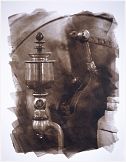 |
| "NedTrain services" This
is a series of photos shot in the NedTrain
services overhaul complex. NedTrain is the former rolling stock maintenance part
of what used to be one company, the Dutch Railways (NS). Contrary to what at first
thought might be expected from such company doing heavy duty maintenance - don't
we all still have in the back of our mind that romantic view of steam clouds and
black iron smiths from the Victorian time when thinking of the "railways"?
- I was struck by the cleanness and order of the workspaces. Minolta
Dynax 7, Sigma 28-70 2.8 EX | 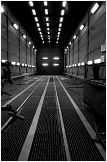 |
| "Ijssel" Zero
Image 4x5 pinhole, Ilford Warmtone FB, sepia toned |  |
| "Jon" Small
personal portrait of a fellow photographer. Minolta Dynax 7,
Sigma 28-70 2.8 EX | 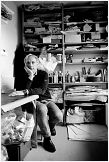 |
| "Haarlem by night" Minolta
Dynax 7, Sigma 28-70 2.8 EX Text of exhibition from the 18th
of August - 13th of September 2009,
ABC Architectuurcentrum Haarlem.  | 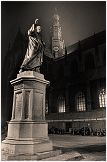 |
| "Fort island Pampus" Little
known even in the Netherlands - even though it is on the World Heritage list of
UNESCO - is a ring of fortresses encircling Amsterdam build between 1870 through
to the 1920's. This ring of fortresses, called "De
Stelling van Amsterdam", was build as a last resort for the Dutch government
in case of an attack on the Netherlands, so an entirely defensive structure. The
defensive strength of this structure was attained by strategically located fortresses
in combination with flooding of the polders surrounding them, making passage of
armies impossible. Ironically, by the time the structure was finished in the 1920's
and an amount of money had been spend equalling the huge investments in the world
famous Dutch Deltawerken,
the concept of fortresses was entirely defeated by the development of the airplane... "Fort
Pampus" was one of the "specials" in the Stelling. It is located
on an artificial island 4 km from the coast into what used to be the Zuiderzee,
the sea that formed the hart of the Netherlands before it was conquered and turned
into a lake by the construction of a 30 km long dike in the 1930's ("De Afsluitdijk").
Fort Pampus was equipped with two main turrets featuring heavy canons capable
of firing 24 km's to fend of enemy ships trying to access the Amsterdam harbour.
Test shots fired with these cannons - the "Stelling" never saw true
combat - revealed some major "design flaws", shattering windows in the
nearby historic town of Muiden (4 km's away!), deafening soldiers and a need to
replaster the walls and ceilings of the fortress after each shot... Today
Fort Pampus is in a decayed, however romantic, state. The Germans removed the
main steel objects, including the canons, by simply blasting the turrets, causing
major damage to the roof structure. As the fortresses lost their strategic military
function by the changes in warfare and the airplane, and the Ministry of Defense
more or less abandoned them, the people of Muiden and others looted the place.
All tiling covering the walls and floors, and other useful objects, were removed,
leaving an empty brick and concrete structure. Still, it's beautiful place to
go to. Tachihara 4x5 |  |
| "People and portraits" Minolta
Dynax 7, Sigma 28-70 2.8 EX; Sinar 4x5, Tachihara 4x5 | 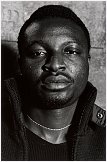 |
| "ENCI cement industry" Three
pictures taken of a silo of the ENCI cement industry in Ijmuiden harbour. Tachihara
4x5 | 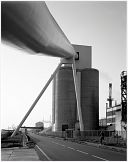 |
| "Kiln in former brick yard 'Blauwe
Kamer'" Since the Netherlands constitutes the estuaries
of two major European rivers, the Maas and Rhine, clay deposites are abundant.
The outer marches of the rivers therefore historically used to be littered with
brick yards. The brick production involved a host of hard manual labor, including
digging the clay, modelling the bricks from clay in wooden frames, drying and
finally firing the bricks in the kiln, as can still be seen in many developing
countries. A few abandoned ones remain up to now, their function replaced by a
handful of highly mechanized large brick factories. Minolta Dynax
7, Sigma 28-70 2.8 EX | 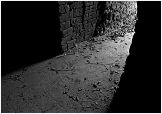 |
| "Westerbork 2nd World War remembrance
center and radio telescopes" This was one sure misty and
gloomy day... however fitting the location. Shot on a cold winter day, with temperatures
at minus 5 degrees Celsius, a slow wind, and a thick fog covering the landscape
as a smothering blanket, rime ice was settling everywhere and working conditions
equally "joyful"... Westerbork used to be a transition
camp during the 2nd World War for people being transported to the German concentration
camps. Today a remembrance center keeps the memories alive. Westerbork nowadays
additionally houses one of the world's largest arrays
of radio telescopes, collecting data in the non-visible parts of the electromagnetic
spectrum, and allowing study of such exotic astronomical phenomena as pulsars
and black-holes.
Minolta Dynax 7, Sigma 28-70 2.8 EX | 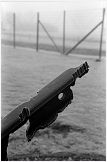 |
| "Quattro Stagioni" Dutch
arcadian landscapes. Tachihara 4x5 | 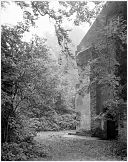 |
| "Haarlem railway station" By
far the most beautiful railway station in the Netherlands, Haarlem station features
magnificent cast iron, masonry, sculpted woodwork and tiling. It makes you wonder
how many precious skills have been lost in the quest for "modernization"
and "prefab" building...? Haarlem railway station is
one of the oldest railway stations in the Netherlands, as the line Amsterdam -
Haarlem was the first railway line build in the Netherlands in the first half
of the 19th century. The current structure was build in the early 20th century
and is in the "Jugendstil" decorative style. Minolta
Dynax 7000i, Minolta 50 1.7, Sigma 28-105 2.8 | 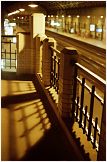 |
| "Underground parking railway station
Arnhem" A number of shots of the underground parking of
the central station in Arnhem. Designed by the well known architects of UN
Studio, this parking almost looks like a spaceship taken straight from a Hollywood
film set. Combined with careful lighting, it creates a very special atmosphere
underground. Minolta Dynax 7, Sigma 28-70 2.8 EX |  |
| "A game of street basketball" "Determination","Fair
play","Concentration","Intermezzo","Joy" Museumplein,
Amsterdam, the Netherlands Minolta Dynax 7, Sigma 28-70 2.8 EX
and Sigma 70-210 EX |  |
| "A game of street basketball" Museumplein,
Amsterdam, the Netherlands Minolta Dynax 7, Sigma 28-70 2.8 EX
and Sigma 70-210 EX |  |
|  |
|